Dry Wire Drawing Machines
Our CRM team manufactures a wide range of dry wire drawing machines, including tension dancer-controlled, straight-line, multi-block, and high-speed models. We design machines to meet various production needs for copper, steel, aluminum, and stainless steel. Whether you need fine wire production, high-volume manufacturing, or specialized applications, our machines ensure reliable performance and top-quality results.
- straight-line wire drawing machines
- direct-drive wire drawing machines
- Fine Wire Drawing Machines
- Rod Breakdown Dry Wire Drawing Machines
- Single-Block Dry Wire Drawing Machines
- Optional Wire Annealing Machines
- Turnkey Solutions
Details of Products
Sky Bluer is a trusted manufacturer specializing in high-end wire processing equipment, proudly offering products under our well-established brand CRM. Our leading product portfolio covers nearly 100 models across 10 major categories, including:
- Wire rod surface treatment line equipment
- Dry wire drawing machines
- Wet wire drawing machines
- Heat treatment production lines
- Surface coating production lines
Dry wire drawing machine reduces the diameter of metal wire by pulling it through a series of dies using powdered (dry) lubricant instead of liquid. It is ideal for high-carbon steel, stainless steel, spring wire, bead wire, and welding wire. The process ensures clean operation, lower maintenance, and better handling of high-tensile wires. As the wire passes through each die, powder lubricant reduces friction and heat. This method is widely used in manufacturing wires for tires, welding, fasteners, and steel ropes.
Features
Sky Bluer is a trusted manufacturer specializing in high-end wire processing equipment, proudly offering products under our well-established brand CRM.

Powder Lubrication System
Dry drawing machines use powdered lubricants to reduce friction between the wire and drawing dies, eliminating the need for liquid handling systems.

Speed Control Method
The machine adopts an AC servo drive system for precise and responsive speed control. This method offers high efficiency, smooth acceleration and deceleration

Cleaner Operation
Since no oil or liquid is used, the wire surface remains cleaner, making post-processing (like plating or coating) easier and reducing cleaning time.

Wire Tempering
The wire tempering process is carried out using linear high-frequency induction heating, supported by a chilled water system to ensure effective cooling of the induction coil.
Sky Bluer – Advanced Wire Processing Solutions Under the CRM Brand
Our CRM team manufactures a range of dry wire drawing machines, including tension dancer-controlled wire drawing machines, straight-line wire drawing machines, direct-drive wire drawing machines, and linear dance wheel tuning-type wire drawing machines. These machines are suitable for drawing a variety of wires such as spring steel wire, bead wire, rope-making wire, optical fiber wire, CO₂ gas-shielded welding wire, flux-cored welding wire, alloy stainless steel wire, aluminum-clad steel wire, and low-relaxation prestressed steel wire.


In the mechanical structure design process, we integrate the best practices from both domestic and international technologies. We customize configurations based on the specific type of steel wire, ensuring each machine meets the unique production needs. By emphasizing demand-side product characteristics, our equipment remains at the forefront of the industry.
Common Questions
Got questions? We've got answers.
What Are the Most Commonly Used Types of Takeup Machines?
In the manufacturing of our straight-line and dry wire drawing machines, users commonly choose from several types of takeup (winding) machines to meet various wire processing requirements. These include spool takeups, high-frame takeups, inverted takeup machines, horizontal takeups, and motorized takeups. Each type provides distinct advantages:
- Spool Takeups: Ideal for winding wire neatly onto spools or reels, ensuring smooth and organized storage.
- High-Frame Takeups: Designed to handle large wire coils with stable support for efficient winding.
- Inverted Takeup Machines: Offer compact design and ease of operation by winding wire in an inverted position.
- Horizontal Takeups: Save floor space by positioning coils horizontally, facilitating easy handling and feeding.
- Motorized Takeups: Equipped with motors for precise speed control, enhancing winding consistency and quality.
Choosing the right takeup machine optimizes wire collection, reduces tangling, and improves overall production efficiency.
What are the typical models available?
Technical parameter for
Block model | 200 | 250 | 300 | 350 | 400 | 450 | 500 | 560 | 600 | 700 | 800 | 900 | 1200 |
Inlet tension strength | ≤800Mpa | ≤800Mpa | ≤1350Mpa | ≤1350Mpa | ≤1350Mpa | ≤1350Mpa | ≤1350Mpa | ≤1350Mpa | ≤1350Mpa | ≤1350Mpa | ≤1350Mpa | ≤1350Mpa | ≤1350Mpa |
Number of block | 14 | 14 | 14 | 14 | 12 | 12 | 12 | 13 | 12 | 10 | 9 | 9 | 2-10 |
Diameter of inlet wire(mm) | 0.3~1.5 | 0.9~2.0 | 1.5~2.8 | 1.8~3.5 | 2.2~4.2 | 3.2~4.8 | 4.0~5.0 | 5.5~6.5 | 6.5~8.0 | 6.15~8.0 | 6.5~12.5 | 8~14 | 8.0~16 |
Diameter of oulet wire(mm) | 0.08~0.4 | 0.25~0.5 | 0.4~0.8 | 0.5~1.2 | 0.6~1.5 | 1.0~2.0 | 1.2~2.5 | 1.35~3.0 | 2.0~3.5 | 2.2~4.0 | 2.5~5.0 | 3.0~6.0 | 3.0~8.0 |
Max.speed | 20~30 | 20~30 | 20~30 | 20~30 | 20~30 | 20~30 | 20~30 | 20~30 | ~15 | ~12 | ~10 | ~10 | ~13 |
Power(kw) | 1.1~4.0 | 3.0~7.5 | 7.5~18.5 | 11~22 | 11~30 | 15~37 | 22~37 | 22~45 | 30~75 | 45~90 | 55~110 | 75~132 | 90~160 |
Speed control method: | AC frequency conversion / DC regulation | ||||||||||||
Control method | Profibus field control system with touchscreen display, human-machine interface, and remote diagnostic capability. | ||||||||||||
Main function | Automatically slows down and stops at a preset wire length. | ||||||||||||
What Are the Differences Between Wet Drawing Machines and Dry Drawing Machines?
Differences Between Wet Drawing Machines and Dry Drawing Machines
Wet Drawing Machines use liquid lubricants—such as oil, water-based solutions, or emulsions—during the wire drawing process. The wire passes through a bath or is sprayed with lubricant to reduce friction and heat. This method provides excellent cooling and lubrication, making it ideal for drawing softer metals or when very fine wire diameters are needed.
Dry Drawing Machines, on the other hand, use powder lubricants instead of liquids. The wire is coated with a dry lubricant that reduces friction as it passes through the dies. Dry drawing eliminates the need for cleaning oil residues from the wire, making it cleaner and easier to handle. It is often used for high-carbon steel, stainless steel, welding wire, and other high-strength wires.
What Are the Differences Between Wet Drawing Machines and Dry Drawing Machines?
Differences Between Wet Drawing Machines and Dry Drawing Machines
Wet Drawing Machines use liquid lubricants—such as oil, water-based solutions, or emulsions—during the wire drawing process. The wire passes through a bath or is sprayed with lubricant to reduce friction and heat. This method provides excellent cooling and lubrication, making it ideal for drawing softer metals or when very fine wire diameters are needed.
Dry Drawing Machines, on the other hand, use powder lubricants instead of liquids. The wire is coated with a dry lubricant that reduces friction as it passes through the dies. Dry drawing eliminates the need for cleaning oil residues from the wire, making it cleaner and easier to handle. It is often used for high-carbon steel, stainless steel, welding wire, and other high-strength wires.
Summary of Key Differences:
Feature | Wet Drawing Machine | Dry Drawing Machine |
Lubrication | Liquid (oil or water-based) | Powder (dry lubricant) |
Cooling | Effective cooling via liquid | Air cooling or fan cooling |
Wire Cleanliness | Requires cleaning to remove oil | Cleaner wire surface, no oil residue |
Suitable Materials | Softer metals, fine wires | High-strength, high-carbon steels |
Maintenance | More complex due to liquid system | Simpler, no liquid handling system |

